the climate of history
for - social sciences paper - The Climate of History - 2009 - species wide perspective of writing history
the climate of history
for - social sciences paper - The Climate of History - 2009 - species wide perspective of writing history
Review of Cold Spring Harbor Laboratory’s Obituary for Dr. James Watson<br /> by [[Lior Pachter]] on Bits of DNA<br /> accessed on 2025-11-08T22:43:12
The hallowed American dream is thegold standard by which politicians and voters alike are meant to measurequality of life as each generation pursues its own definition of happinessunfettered by the restraints of birth (who your parents are) or station (theposition you start out from in the class system).
Did it help that America was broadly formed during the start of the Industrial Revolution and at a time in which social mobility was dramatically different than the period of history which proceeded it?
And how much of this difference is split with the idea of the rise of (toxic) capitalism and the switch to "keeping up with the Jonses" which also tends to drive class distinctions?
I've highlighted the shit out of this because I believe it actually argues a fundamental truth: communicating electronically is, indeed, a better way of communicating.
I don't think this friendship had to die, but the illusion of romance probably did. I'm going to do my best to choose to ignore the confirmation bias within me - could it be the absence of stigma that enabled these realizations? Is the stigma, itself, then, now a virtually all-powerful (beyond any measure of reflection) force which will never allow us to progress???
Fuck hype, man.
Incidentally, when a straightforwardly “I’m a Nazi” Nazi showed up in the beta, people used the report function, and the Bluesky team labeled the account and banned it from the Bluesky app and restricted promotion of the account of the person who invited him. This changed exactly none of the tenor of the Nazi conversation on Mastodon, but it happened.
Now just imagine the equivalent on the scale of an entire server and you've got the story of Mastodon's incredibly centralized, swift expulsion of Gab's influence. Here's The Verge's version for the moment.
Just type in a username and password and off you go.
Unlike other mainstream social platforms, the primary way content is distributed on TikTok is through an algorithmically curated “For You” page; having followers doesn’t guarantee people will see your content. This shift has led average users to tailor their videos primarily toward the algorithm, rather than a following, which means abiding by content moderation rules is more crucial than ever.
Social media has slowly moved away from communication between people who know each other to people who are farther apart in social spaces. Increasingly in 2021 onward, some platforms like TikTok have acted as a distribution platform and ignored explicit social connections like follower/followee in lieu of algorithmic-only feeds to distribute content to people based on a variety of criteria including popularity of content and the readers' interests.
https://del.icio.us is up ! 🥳
Can log in, browse through bookmarks and export them.
is zettelkasten gamification of note-taking? .t3_zkguan._2FCtq-QzlfuN-SwVMUZMM3 { --postTitle-VisitedLinkColor: #9b9b9b; --postTitleLink-VisitedLinkColor: #9b9b9b; --postBodyLink-VisitedLinkColor: #989898; }
reply to u/theinvertedform at https://www.reddit.com/r/Zettelkasten/comments/zkguan/is_zettelkasten_gamification_of_notetaking/
Social media and "influencers" have certainly grabbed onto the idea and squeezed with both hands. Broadly while talking about their own versions of rules, tips, tricks, and tools, they've missed a massive history of the broader techniques which pervade the humanities for over 500 years. When one looks more deeply at the broader cross section of writers, educators, philosophers, and academics who have used variations on the idea of maintaining notebooks or commonplace books, it becomes a relative no-brainer that it is a useful tool. I touch on some of the history as well as some of the recent commercialization here: https://boffosocko.com/2022/10/22/the-two-definitions-of-zettelkasten/.
https://genizalab.princeton.edu/about/history-princeton-geniza-lab
But a 1901 article(link is external) by Solomon Schechter hinted at the cache’s potential for social history.
https://mleddy.blogspot.com/2005/05/tools-for-serious-readers.html
Interesting (now discontinued) reading list product from Levenger that in previous generations may have been covered by a commonplace book but was quickly replaced by digital social products (bookmark applications or things like Goodreads.com or LibraryThing.com).
Presently I keep a lot of this sort of data digitally myself using either/both: Calibre or Zotero.




Funnily enough one of the reasons I started looking into the decentralized social media space in 2016, which ultimately led me to go on to create Mastodon, were rumours that Twitter, the platform I’d been a daily user of for years at that point, might get sold to another controversial billionaire.
😬
Intellectual historians have never really abandoned the GreatMan theory of history. They often write as if all important ideas in agiven age can be traced back to one or other extraordinary individual– whether Plato, Confucius, Adam Smith or Karl Marx – rather thanseeing such authors’ writings as particularly brilliant interventions indebates that were already going on in taverns or dinner parties orpublic gardens (or, for that matter, lecture rooms), but whichotherwise might never have been written down
The Great Man theory of history is the misconception that all the most important ideas can be traced back to a single great individual—usually a man—and ignoring the fact that they had likely been brewing in the social milieu of their time before being encapsulated, like a bug in ember, by a particular writer who then gets an outsized amount of credit for "inventing" the idea.
I wonder if the effect of social media and ubiquity of communication will dampen this effect?
social evolution
How did we get here?
Yesterday (October 26, 2021), I picked up David Graeber’s book, The Dawn of Everything: a New History of Humanity, written with David Wengrow, at Coles in Abbotsford.
It is interesting to note that David Graeber was interested in the origins, the beginnings.
Renowned for his biting and incisive writing about bureaucracy, politics and capitalism, Graeber was a leading figure in the Occupy Wall Street movement and professor of anthropology at the London School of Economics (LSE) at the time of his death.
Drawing on path-breaking research in archaeology and anthropology, the authors show how history becomes a far more interesting place once we learn to throw off our conceptual shackles and perceive what's really there.
Reimagining our social architecture might begin with rethinking our past and origins as a species.
The minds of other people can also supplement our limited individual memory. Daniel Wegner, a psychologist at Harvard, named this collective remembering “transactive memory.” As he explained it, “Nobody remembers everything. Instead, each of us in a couple or group remembers some things personally — and then can remember much more by knowing who else might know what we don’t.” A transactive memory system can effectively multiply the amount of information to which an individual has access. Organizational research has found that groups that build a strong transactive memory structure — in which all members of the team have a clear and accurate sense of what their teammates know — perform better than groups for which that structure is less defined.
Transactive memory is how a group encodes, stores, and shares knowledge. Members of a group may be aware of the portions of knowledge that others possess which can make them more efficient.
How can we link this to Cesar Hidalgo's ideas about the personbyte, etc.?
How would this idea have potentially helped oral cultures?
She uses the example of a trauma resuscitation team helping to shorten hospital stays, but certainly there are many examples in the corporate world where corporate knowledge is helpful in decreasing time scales for particular outcomes.
The Social Web.
The "Social Web" was a thing by this point
NetScience[@net_science] (2020-08-23) Pseudoscientific Content on YouTube: Assessing the Effects of Watch History on the Recommendation Algorithm. (arXiv:2010.11638v1 [http://cs.CY]) http://arxiv.org/abs/2010.11638. Twitter.Retrieved from: https://twitter.com/SciBeh/status/1319564893503225856
As I began to get a feel for the passions and frustrations of teens and to speak to broader audiences, I recognized that teens’ voices rarely shaped the public discourse surrounding their networked lives.
Again, putting this into historical context, is this sentence different for any prior period if we remove the word "networked"?
It's been a while, but the old saw "A child should be seen and not heard" comes quickly to mind for me.
History doesn’t ask you if you want to be born in a time of upheaval, it just tells you when you are.
If you look long enough you can find my early terrible writing. You can find blog posts in which I am an idiot. I’ve had a lot of uninformed and passionate opinions on geopolitical issues from Ireland to Israel. You can find tweets I thought were witty, but think are stupid now. You can find opinions I still hold that you disagree with. I’m going to leave most of that stuff up. In doing so, I’m telling you that you have to look for context if you are seeking to understand me. You don’t have to try, I’m not particularly important, but I am complicated. When I die, I’m going to instruct my executors to burn nothing. Leave the crap there, because it’s part of my journey, and that journey has a value. People who came from where I did, and who were given the thoughts I was given, should know that the future can be different from the past.
Atlani-Duault, L., Chauvin, F., Yazdanpanah, Y., Lina, B., Benamouzig, D., Bouadma, L., Druais, P. L., Hoang, A., Grard, M.-A., Malvy, D., & Delfraissy, J.-F. (2020). France’s COVID-19 response: Balancing conflicting public health traditions. The Lancet, 0(0). https://doi.org/10.1016/S0140-6736(20)31599-3
Gauri, V. (2020 April 30). Behavioral Public Policy Faces a Crisis. Behavioral Scientist. https://behavioralscientist.org/behavioral-public-policy-faces-a-crisis/
Edelmann, A., Wolff, T., Montagne, D., & Bail, C. A. (2020). Computational Social Science and Sociology. Annual Review of Sociology, 46(1), annurev-soc-121919-054621. https://doi.org/10.1146/annurev-soc-121919-054621
Ah, Jane, I take your place now, and you must go lower, because I am a married woman
Traditionally your rank in life stated where you sat at the dinner table. Since Lydia was the first Bennet daughter to be married, she took Jane's spot on her father's right. A married women came before the eldest daughters and the older daughter was superior than the younger children in rank. (John Trusler, The Honours of the Table, 4)
— shire
Throughout her books you will see that Austen redacts some peoples and places names with --. It was common during the 18th and 19th century for authors to do so to either avoid inaccuracies or avoid being accused of writing about real people and places. By not giving the name of the militia that Wickham was a part of, Austen is able to continue the realism of her novels by avoiding creating a fictitious place while also separating her characters from any real people who would not want to be affiliated with the actions of Wickham.<br> https://english.stackexchange.com/questions/9479/why-in-old-books-are-dates-often-given-with-the-years-redacted
breakfast-room
A breakfast room was designed to be in close proximity to the kitchen. This room was designed to offer a relaxing and comfortable space to have the first meal of the day.
carriage was sent to meet them at — , and they were to return in it by dinner-time.
Hackneys, or public carriages for hire, made their first significant appearance in the early 17th century. By 1694, this method of transportation was very popular so the Hackney Coach Commission was established in London.
https://janeaustensworld.wordpress.com/tag/regency-transportation/
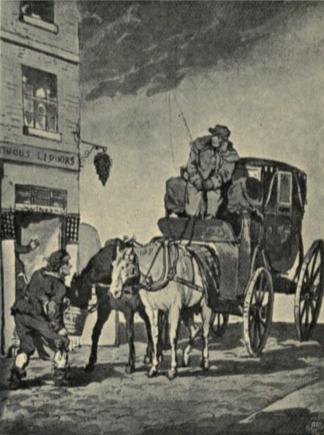
thousand pounds
The buying power of a thousand pounds, is equivalent to the buying power of $87,093 US dollars today.
She sat intently at work
"Work done with a needle; spec. the art or practice of sewing or embroidery. Also: sewn or embroidered items collectively" (OED).
A lady can continue her light needlework during morning calls, but all other activities must be stopped at the entrance of guests.<br> http://www.mrsbeeton.com/01-chapter1.html
Here, Sarah, come to Miss Bennet this moment, and help her on with her gown. Never mind Miss Lizzy’s hair.”
The social and economic status of a family could be determined by the number of servants in a household. The Bennets could only afford the essential staff needed to maintain the home: a butler, housekeeper, cook, and two housemaids. Here, a Lady's Maid would usually perform the duties of dressing and fixing the hair of the ladies of the house. Sarah might be a maid-of-all-work, undertaking all the duties of the home that would usually be assigned to various hired maids.
https://www.kristenkoster.com/a-primer-on-regency-era-servants/
http://www.jasna.org/persuasions/on-line/vol35no1/walshe.html
dressing-room
A room primarily used during one's morning routine for dressing and washing. A woman's dressing room was made to be private and comfortable, and the intimacy of these small places allowed women to entertain small parties of other female guests. The wealthier the woman, the more luxurious her dressing room.

https://janeaustensworld.wordpress.com/tag/18th-century-dressing-rooms/
He is gone to my father already
The Hardwicke Act for the Prevention of Clandestine Marriages passed in 1754, enforcing couples marrying in England to follow certain rules in order to be legally married. One of these rules was obtaining the consent of the father. Any couple under twenty-one needed the consent of a parent or guardian if the child was legitimate. If a couple married without consent, then by law their marriage was void.
https://byuprideandprejudice.wordpress.com/2014/01/28/courtship-and-marriage-in-the-regency-period/
a letter to write
Letter writing was an imperative part of Regency social life. It was taken seriously as a real pastime and hobby, as letters were the only way to communicate with long distance friends and family. It was standard for letters to be written privately and it was preferred to write during the morning hours. Women were especially encouraged to become adept at letter writing as it was seen as a necessary accomplishment.
http://randombitsoffascination.com/2014/10/07/touch-quill-ink-regency-letter-writing/
sash
Sashes were accessories that women could wear with any dress, for any occasion. It was fashionable for women to wear dresses that accentuated their waists and bodies, so sashes were wrapped around the waist and under the breasts.
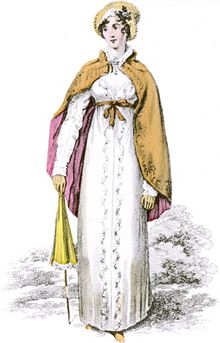
curricle
Unlike a carriage, which is four-wheeled; a curricle is two-wheeled. Both are drawn by horses and this picture showcases how lavish a curricle can be.

livery
This picture showcases that a livery is very fine and elegant. An emphasis is focused on the fancy standard that is within the uniform's conception.

Her teeth are tolerable
During the 1770's dentistry was becoming a popular subject and profession. The higher the class the more access to sweets that could cause cavities and decay in teeth. However, these classes also had access to tooth powders and picks (Jane Austen's England: Daily Life in Georgian and Regency Periods).
— — shire
"This is standard eighteenth- and nineteenth-century practice to create a sense of realism: the author leaves out the name of the country or person, thus pretending it is a real one and that he or she does not wish to intrude upon the privacy of real people" (The Victorian Web).
all meeting frequently at St. James’s
The Palace of St. James was where the royals like King George III lived prior to Buckingham Palace. They would host balls in celebrations of "official nativities of the King and Queen" (Thompson) where people of Sir William's rank and higher attended. Sir William is referencing an earlier scene in chapter six asking Darcy if he ever danced at St. James's. (http://www.jasna.org/persuasions/on-line/vol33no1/thompson.html)
 (https://janeaustenslondon.files.wordpress.com/2013/04/st-jamess-palace-1-copy.jpg)
(https://janeaustenslondon.files.wordpress.com/2013/04/st-jamess-palace-1-copy.jpg)
properly sanctioned
“Allowed by Authority” Marriages must be recognized by both law and God to be proper (OED).
three or four hundred a year
In 2019, 300 pounds would be equivalent to $30,372.96 while 400 pounds would be equivalent to $40,497.28. 1802 is the closest year to input the information because in the following paragraph, there is an indirect reference to the Treaty of Amiens which took place between 1802-1803. https://www.uwyo.edu/numimage/currency.htm
barouche-box
 Similar in style to the modern day convertible, the barouche-box was a four-wheeled carriage with a falling top. It had two sets of double seats, positioned to face each other, and a seat for the driver, called the box, outside of the carriage. Due to its light, somewhat flimsy design, it was regarded as a summer carriage.
Similar in style to the modern day convertible, the barouche-box was a four-wheeled carriage with a falling top. It had two sets of double seats, positioned to face each other, and a seat for the driver, called the box, outside of the carriage. Due to its light, somewhat flimsy design, it was regarded as a summer carriage.
Netherfield ball
Ball that Mr. Bingley invites the Bennet family to. This ball was a way for Mr. Bingley to spend more time courting Jane. This was the proper way for men to court women in this time. It was also an opportunity for Elizabeth to spend time with Wickham but when he doesn't show up, Elizabeth spends time with Mr. Darcy, pushing their complicated love story further. Mr. Darcy also uses the ball as a proper way to court Elizabeth in his own way.
Daughters are never of so much consequence to a father.
In Austen's time, the importance of passing down a legacy to a male heir is heavily stressed. Oftentimes things like property and money are passed down to the nearest male heir, even if that means skipping any direct children for inheritance. It is very rare for a woman to inherit.
Miss De Bourgh exerted herself so far as to curtsey and hold out her hand to both
Curtsying is a sign of respect typically used by those of lower status to address those of higher status. In this case, Anne De Bourgh is showing deference to Elizabeth and Lady Catherine curtsying first, which is somewhat strange, considering she is of higher status. By holding her hands out, she is also expecting a similar show of respect back.
I may suffer from the want of money. Younger sons cannot marry where they like.”
In 18th century finances, typically, the oldest son is the one who usually inherits most of the family money and estates, leaving the younger sons to look for wealth through marriages to women of wealthy families. "Younger sons with no expectations of succeeding to any paternal property, might come to inherit the estates of much wealthier families to whose heiresses they could never have hoped to aspire."
Clay, Christopher. “Marriage, Inheritance, and the Rise of Large Estates in England, 1660-1815.” The Economic History Review, vol. 21, no. 3, 1968, pp. 503–518. JSTOR, www.jstor.org/stable/2592747.
but fifteen
The Marriage Act of 1753, or Lord Hardwicke's Act, prohibited marriages for those under 21 without a parent or guardian's consent (Marriage Act 1753, PERFAR https://www.perfar.eu/policies/marriage-act-1753)
The envelope itself was likewise full.
The cost of a letter was dependent on length and number of pages. Likewise, envelopes didn't come into common use until 1840 (Leslie Adkins, Jane Austen's England, 235-236).
inferiority of your connexions? — to congratulate myself on the hope of relations, whose condition in life is so decidedly beneath my own?”
Connexions - "Relationship by family ties, as marriage or distant consanguinity. Often with a and plural" (OED).
Technically, Mr. Darcy and the Bennet family are from the same class, the gentry, but he has better connections. Mr. Darcy is related to Lady Catherine De Bourgh who holds the highest title a woman can have within the Gentry class. Comparatively, the Bennet's are related to the Gardiners, who are in a class below the gentry, the professional class.
executors of my father’s will
"Before 1858, the executor or executrix would register the will in the relevant ecclesiastical court to obtain a grant of probate, thereby allowing the bequests to be fulfilled" (BBC, https://www.bbc.co.uk/history/trail/familyhistory/journey_life/research_tools_04.shtml).
entail
"Law. The action of entailing; the state of being entailed. The settlement of the succession of a landed estate, so that it cannot be bequeathed at pleasure by anyone possessor; the rule of descent settled for any estate; the fixed or prescribed line of devolution" (OED).
fifty pounds
Equivalent to about $3,627.75 as of 2019.
Links to common words/themes throughout the annotations
pools at quadrille
Quadrille, according to David Parlett was a wildly popular card game of the period. "A notable characteristic of Quadrille is that it was always more popular with women than with men." The pool is the main stake of each round, like the collected bets in poker.
ten thousand a year
Darcy’s income was more than 300 times as much the average per capita income of his time. Translated into today’s currency, Mr. Darcy would have an annual income of over $300,000 (http://www.jasna.org/persuasions/printed/number12/heldman.htm).
accomplished girl
Women learned specific skills to make themselves more desirable to potential suitors. The accomplished woman read appropriate books and was knowledgeable in math, science, French, social science, music, art, dance, and needlework. Women were expected to socialize well and serve the family with skills that would not challenge her husband (http://randombitsoffascination.com/2014/11/04/accomplished-lady/).
phaeton
"A type of light four-wheeled open carriage, usually drawn by a pair of horses, and having one or two seats facing forward" (OED).
 Image of a light phaeton (Two Nerdy History Girls).
Image of a light phaeton (Two Nerdy History Girls).
gig
"A light two-wheeled one-horse carriage" (OED).

Image of a Standhope-style gig (Wikipedia).
fish
“A small flat piece of bone or ivory used instead of money or for keeping account in games of chance; sometimes made in the form of a fish” (OED).
Fish made from ivory (Austenonly.com):

Other shapes, made of mother-of-pearl (Austenonly.com):

The first part of Mrs. Gardiner’s business on her arrival was to distribute her presents and describe the newest fashions. When this was done she had a less active part to play. It became her turn to listen
This paragraph is written right after the paragraph where it mentions that Mrs. Gardiner is an "intelligent, elegant woman", which is interesting because it goes directly to the role she has to play as a woman. Mrs. Gardiner talking about the latest fashions suggests her social ranking as well since women of upper class were the ones who mostly experienced changing fashion and middle class women wore the same outfits (Life for Women in 18th Century). The change of topic in the paragraphs also ignores her intelligence and instead shows her focusing on topics she should care about as a woman because that was her role.
Mr. Gardiner was a sensible, gentlemanlike man, greatly superior to his sister, as well by nature as education. The Netherfield ladies would have had difficulty in believing that a man who lived by trade, and within view of his own warehouses, could have been so well-bred and agreeable. Mrs. Gardiner, who was several years younger than Mrs. Bennet and Mrs. Philips, was an amiable, intelligent, elegant woman, and a great favourite with all her Longbourn nieces.
It's well known that men had an advantage of getting a proper education which explains Mr. Gardiner's intelligence. This paragraph shows that Mrs. Gardiner was "amiable, intelligent" which shows that she had some form of an education. For women, getting an education was different than men because not all females got an education. According to the article, "Life for Women in 18th Century", if women got an education, it is usually because they were wealthy and were able to go to boarding school. Some women, not everyone, of lower class learned basic reading and writing skills. Although this doesn't mention her background and what exactly it means by "intelligent", it makes me wonder which social class she was raised in and if she really did get education.
The discussion of Mr. Collins’s offer was now nearly at an end, and Elizabeth had only to suffer from the uncomfortable feelings necessarily attending it, and occasionally from some peevish allusion of her mother
Mrs. Bennet is so upset with Elizabeth not accepting the proposal because in the late 18th century getting married was important for young ladies, for future economic concerns, especially for those women who wouldn't be left anything after their father's death (Maurer, Courtship and Marriage).
Netherfield,
The 1995 BBC Pride and Prejudice television adaption used the historical Edgcote House as Netherfield. "Edgcote House, located in southwest Northamptonshire, is the setting for Mr. Charles Bingley’s leased estate. The building was built in the 18th century, and was at one time owned by Anne of Cleves, who was Henry VIII’s fourth wife, and one who was actually allowed to keep her head!" (https://austenauthors.net/a-tour-of-estate-houses-used-in-pride-and-prejudice/)
a ball
BBC recreates what it would have been like at the Pride and Prejudice ball. https://www.youtube.com/watch?v=63lLJFBiV_M
the Boulanger
The Boulanger was the closing dance at a ball, in which couples would align in a circle, turning dancers and their partners, and then repeated the dance in the opposite direction (https://www.yorkregencydancers.com/regency-dance.html). Below is a depiction of the dance. https://www.youtube.com/watch?v=nuSa5JLUAAY
assemblies
Assemblies refers to social events that were held in local Assembly Rooms for the public. They were often balls, as in this case. The Assembly Rooms were large public spaces built for such an occasion.
chaise and four
A chaise and four is a small carriage pulled by two to four horses with two to four wheels

Mr. Collins was only a clergyman
Being a clergymen as a living meant a guaranteed income and home for the lifetime of the clergyman lucky enough to be appointed to one. Since the incumbent did not receive a wage or sully his hands with works per se, it was considered a gentlemanly profession and many younger sons of gentlemen pursued the church as their career."
(Grace, Maria. Vicars, Curates, and Church Livings. Random Bits of Fascination. Web.)
coming out
"Emerge; become known." (OED).
though he had been invited only to a family dinner, she would take care to have two full courses.
In the 18th century, dinner was the main meal of the day and it was especially eventful if there were guests invited. The number of courses often changed but essentially each course would offer something different, one might be a soup and the next a meat. Based off of the Bennet's status they probably would have eaten cheaper meat like mutton (Porter, 18th- Century Food).
Why should he have it more than anybody else?”
Until the the Married Women's Property Act of 1882, women could not have this privilege—and even then, you had to be married and have your husband's name! Mrs. Bennet has every right to fear the possibility that Charlotte and Mr. Collins could threaten the Bennet family and kick them out of their home.
Day after day passed away without bringing any other tidings of him than the report which shortly prevailed in Meryton of his coming no more to Netherfield the whole winter
According to and article titled Courting the Victorian Women, "Courtship was considered more a career move than a romantic interlude for young men, as all of a woman's property reverted to him upon marriage". Mr. Bingley traveling is discussed as everyone's business, and "reports" are updated of his whereabouts. It's not that the town where the Bennet's live is gossipy, but rather so many young women are hoping to marry Mr. Bingley and wait for the opportunity to run into him conveniently, or can know how many times he has gone to see Jane Bennet etc.
she could no longer be blind to Miss Bingley’s inattention
“A call should be returned with a call, a card with a card, within one week, or at the most, ten days.” (Hoppe "Calling Cards and the Etiquette of Paying Calls")
ten thousand pounds
Ten thousand pounds is somewhere around 1,090,000 GBP adjusted for inflation from 1800. However, inflation rates vary; so this number is approximate ("Historical UK Inflation Rates Calculator").
For context: Miss Bingley, and Mrs. Hurst have twenty thousand pounds (ch. 4). Miss Darcy is worth thirty thousand (ch. 35). The Bennet sisters are splitting their mother's fortune of five thousand pounds (ch. 50).
entailed
“To settle (land, an estate, etc.) on a number of persons in succession, so that it cannot be bequeathed at pleasure by any one possessor” (OED).
cassino
Also spelled casino; "a card game for two to four people" (Pool, What Jane Austen Ate…, 281).
quadrille
"A card game played by four people with forty cards that was the fashionable predecessor of whist" (Pool, What Jane Austen Ate…, 360).
out
From “to come out”—when a young woman formally enters adult society, usually at 17 or 18, and is eligible for marriage (Pool, What Jane Austen Ate…, 288).
polished societies.
The description of societies as being polished is referring to them as being "refined, cultured, or elegant"(OED).
Scotch and Irish airs
“A tune, a melody; a piece of music in which a single melodic line predominates, and which has little or no distinctive accompaniment”(OED).
house was handsome and handsomely fitted up
This saying refers to a home in the eighteenth or nineteenth century that had elegant furniture throughout the home; and elegant dishes and dinnerware. The servants lived in brand new liveries. (janeaustens world)
rubber
According to the OED, rubber refers to "A set of games (usually three or five), the last of which is played to decide between the opponents when each has won an equal number; (hence) the winning of more than half the individual games by one side" (OED).
This phrase altogether indicates that Lady Middleton was partaking in a card game upon hearing the news of Marianne.
barouche
"A carriage with a half-head behind which can be raised or let down at pleasure, having a seat in front for the driver, and seats inside for two couples to sit facing each other" (OED).
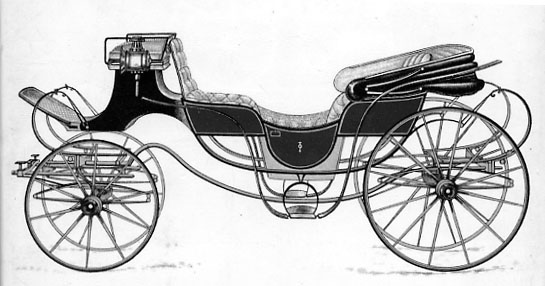
they openly correspond
For a young, unmarried woman such as Marianne to correspond with an unmarried man was considered extremely improper. In fact, for a single woman to initiate such correspondence would be considered scandalous, thereby tarnishing her virtue and reputation as an eligible bridal candidate. Only if they were engaged to each other would this practice be looked upon favorably; in fact, it might be necessary and expected. If they were not engaged, and especially not to each other, open correspondence would indicate a lack of morals in the woman, in that society would assume the young woman to be the man's mistress. Brandon follows this statement by extrapolating that Marianne and Willoughby would soon be married, since that would be the only alternative so her social reputation would not suffer.
His card was on the table
"Calling cards became popular at the end of the 18th century and bore the visitor's name, title and residence." (Grace, Maria. "Morning Calls and Formal Visits: Socializing in the Regency Era" English Historical Fiction Authors, http://englishhistoryauthors.blogspot.com/2013/08/morning-calls-and-formal-visits.html . Accessed 24 April 2017.) The purpose of the calling card that Willoughby leaves behind at Mrs. Jennings' residence serves to inform her, as the mistress of the house, of his presence in London. As her acquaintance, it would have been considered rude of him not to do so.
the footman
"An attendant or foot servant; one employed to run ahead of or alongside a coach, carriage" (OED).
veal cutlets
"The flesh of a calf as an article of diet. A calf...as killed for food or intended for this purpose. Now rare. Chiefly in names of dishes. Made from veal, as veal pie, veal broth, veal cutlet, veal gravy" (OED).
take orders
To "take orders" means to ordain as a clergyman to the Anglican Church. In the Regency era, many young gentlemen looked to the church as a professional option, especially younger sons who had no other inheritance or estate.
I would have every young woman of your condition in life acquainted with the manners and amusements of London
At this time it was not unusual for women to go to London or other urban settings for access to different experiences. They offered many opportunities for new social interaction and there is ample evidence of women traveling to London and partaking of its many social activities. There were also many opportunities of new experiences for pleasure and excitement, some through social interaction. http://www.bbc.co.uk/history/trail/victorian_britain/women_out/urban_life_04.shtml
chaise
Short for 'post-chaise', defined as ""a horse-drawn, usually four-wheeled carriage (in Britain usually having a closed body, the driver or postilion riding on one of the horses) used for carrying mail and passengers, esp. in the 18th and early 19th centuries"" (OED).
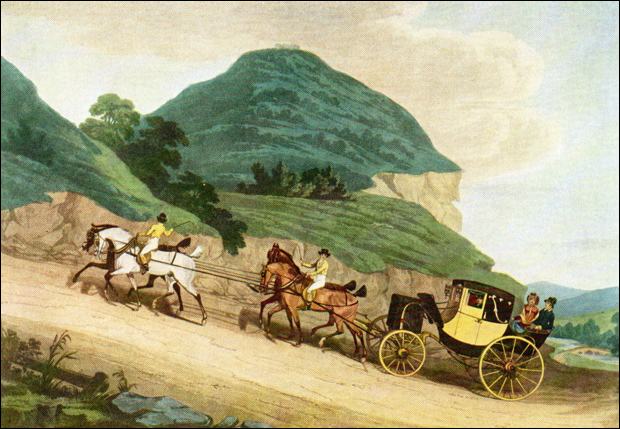
traded
The tradesmen or middle sort are below Gentry and make their money by working. They could have as much or more money than the gentry class in some cases, but their status was always considered as lower.
http://www4.wittenberg.edu/academics/hist/crom/brit/socstruc.html
drawing-room
"A room reserved for reception of company, and to which the ladies withdraw from the dining-room after dinner" (OED).
The drawing-room had feminine decorations compared to the other rooms in a home; which included classically tasteful furnishings and musical instruments" (Drawing rooms, The Regency Town House).
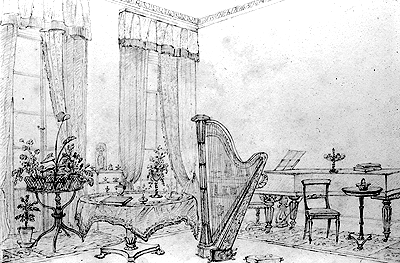
On every formal visit a child ought to be of the party, by way of provision for discourse.
As Florence Hartley notes in her conduct book, "When a child is present in a formal visit or call, he is the first subject in a conversation" (Hartley, The Ladies' Book of Etiquette, and Manual of Politeness, Chapter 16. S.l.: OMNIA VERITAS, 2015).

Lady Middleton
The fact “Lady Middleton” is referenced without her first name illustrates to the reader that she was married by a man with a title. However, in the novel Pride and Prejudice Lady Catherine de Bourgh is addressed with her first name indicates she was born into nobility.
(The British System of Aristocratic Honorifics, The Republic of Pemberley)
setting your cap
Said of a woman who determines to gain the affections of a man....Origin: from the French nautical phrase 'mettre le cap sur' - 'to set a course for'... Women commonly wore caps of white linen or muslin in the 18th century. Any woman who was intent on attracting a man would certainly wear her best cap, probably ornamented with lace and ribbons, and set it at the most becoming angle… By the early 19th century the phrase was common enough to have taken on a metaphorical usage. ('Set One's Cap At' - the Meaning and Origin of This Phrase. Phrasefinder.)
walk
"In Jane Austen’s day most people walked to work, town, church, and market square, or to their neighbors. Six miles was not considered an undue distance to travel by foot one way. The gentry were another breed. They either owned their own carriages or hired a public horse cab." (Victorian and Edwardian Horse Cabs by Trevor May, a Book Review, Jane Austen's World)
curricle
"The fashionable carriage now is a curricle, and the most elegant of that fort is one built by." Times [London, England] 2 Aug. 1787: 3. The Times Digital Archive. Web. 25 Apr. 2017.
This carriage was deemed to be one of the fashionable ones; this could only shed good light on Willoughby and alludes to his class and his fashion style. It was deemed to be an elegant mode of transportation, which helps contribute to the Dashwoods' impression of Willoughby.
but I would not go while Mrs. Smith was there, and with no other companion than Mr. Willoughby.”
In the Regency era, it was common for people to visit private homes and estates. There was a "presumption of access to private houses" (Clarke, "A fine house richly furnished: Pemberley and the visiting of country houses") In this discussion, Elinor is chiding Marianne for breaking one of the cardinal rules of visiting a great house: visiting while the family who owned said house was at home. "If the family were away, [a] housekeeper would feel free to show the house to visitors" but "access [could be] refused because the family were at home" (Clarke). By entering Allenham while Mrs. Smith was at home, Marianne has intruded. The fact that she was also alone with Willoughby, a man who is not a relative of hers, with no supervision from others could cause people to question Marianne's virtue.
he has got a lock of her hair.”
"Among family, friends and romantic partners, exchanging a lock of hair was a sign of mutual esteem and deep affection. Upon the death of a loved one, locks of hair were often cut and kept as a way to both honor and remember the dead... [H]air was both an intimately personal souvenir of a specific person and an (almost) everlasting memento." ("Hairwork jewelry" on the Fashion Institute of Design and Merchandising (FIDM) Museum of Los Angeles' blog) Locks of hair were often kept in the form of jewelry, as we see Edward Ferrars wearing later in the novel. Hair jewelry ranged from simpler rings like the one Edward wears to complex necklaces, brooches, and other pieces.
 (Image: "Gold and enamel mourning ring with hair of the deceased under glass, c. 1855." from The Victor Mourning Blog)
(Image: "Gold and enamel mourning ring with hair of the deceased under glass, c. 1855." from The Victor Mourning Blog)
(Image: "Hairwork necklace. 1850-1890. Gift of Andrea Tice. 2008.46.101" from the FIDM Museum Blog)
christian name
The term "Christian name" refers to one's first or given name, which was often given at the time of an infant's baptism (Thurston, Catholic Encyclopedia). An excerpt from Etiquette for Ladies, published in Philadelphia in 1840 by Lea & Blanchard, details some specifics on the use of Christian names in different types of company: "In speaking, it is always proper to give the name of Sir, Madam, or Miss... It is equally good [etiquette], when alone with [one's husband], to designate him by his Christian name." The use of a Christian name, or given name, was incredibly intimate and for the most part only meant to be used by family members in private spaces.
she must buy another for the servant
In the Regency period, women were not permitted to ride alone, except under very specific circumstances, and were usually expected to be accompanied by a chaperone. This chaperone was often a groom, whose duties also included caring for the horses. "A lady was permitted to drive her own carriage, but only about the town attended by a groom, or by herself on the family estate... It was acceptable to go out riding or driving with a man as long as a groom or other chaperone was in attendance... It was acceptable to go out driving or riding with a man without a chaperone if he was a relative of close family friend" (Kloester, Georgette Heyer's Regency World).
He had not seen me then above twice
In her conduct book, Letters to Young Ladies on their Entrance into the World (1824), Elizabeth Lanfear warns women not to rush into marriage: "love-matches, at least those which are generally so called, do not always prove the happiest ; and, when entered into rashly, or at an early period of life, before either the taste or the judgement are sufficiently matured, mutual disappointment is too frequently the result" (Lanfear, p. 49). Lanfear is stating the possibility that marriage can lead unhappiness and warns women not to rush into marriage. If Colonel Brandon proposed the idea of marriage to Charlotte to Sir John, Charlotte might have needed Lanfear's advice not to jump into marriage so rashly.
carriage
Horse-drawn carriage used in the 18th and 19th centuries; a status symbol of material wealth used by the upper classes.

to make a ring, with a plait of hair in the centre, very conspicuous on one of his fingers.
“Hair jewelry served as a physical demonstration of internal feelings, similar to the idea of sensibility”
(Absorption in Austen,On Hair Jewelry). The act of a man carrying a woman's lock of hair is a symbol of love between the two lovers. It is an act of affection as the lock of hair can also represent a woman's beauty and virtue. By gifting a lock of hair a woman is in a way promising herself to her lover, and in return the man carries and protects the lock which is his way of symbolizing that her will protect her virtue.

leave his estate from his nephew;
“England was a very patriarchal society. Not only in the public sphere, but also in the private one as well. Women did not have any power in any portion of the nation, whether it be economic, political, or social. In England there was no law written expressly concerning inheritance other than, that the will or desire of the man of the home or estate will be carried out. This meaning that if the man of the estate wished for his nephew to inherit the land it was to be so. The common practice was that a son or nephew to the head of the family was to inherit all of the assets, because he would be more worthy of the property than a woman.” (Davis, Brooke. Inheritance Laws in the Early 1800s in England, Web)
succession to the Norland estate
“Before the nineteenth century, most families were organized according to patriarchal tradition. Household heads owned and controlled the means of production, and their wives and children were obliged to provide the unpaid labor needed to sustain family enterprises. Masters of the household had a legal right to command the obedience of their wives and children—as well as any servants or slaves—and to use corporal punishment to correct disobedience.“ (Ruggles, Steven. Patriarchy, Power, and Pay, Web)
but she knew that this kind of blunder was too common for any sensible man to be lastingly hurt by it
Elizabeth Lanfear describes the repercussions of marriage and the commonality of how marriages occur: “marriage, generally speaking, in either sex, is more frequently the result of accident than of selection : propinquity, convenience, interest, or, at best, mere fancy, dignified by the name of love, forms the basis, of most matrimonial engagements” (Lanfear, Young Ladies on their Entrance into the World, p. 47). Lanfear's statement on marriage relates to this moment where Elinor notes her knowledge of this common type of marriage. In relation to Lanfear's statement, Elinor notices the infatuation between Mr. Palmer and his wife being the main attraction that led to their marriage.
The studied indifference
In her conduct book published in 1824, Elizabeth Lanfear explains the etiquette expected from married women: “a sensible woman, to preserve the peace and secure the affections of her husband, will often sacrifice her own inclinations to his” (Lanfear, Young Ladies on their Entrance into the World, p. 67). Lanfear states that married woman are expected to sacrifice their tendencies and desires for those of her husbands. In regard to the relationship between Charlotte Palmer and her husband, this same etiquette is very strongly illustrated. In this particular moment, Charlotte is being selflessly tolerant to her husband's comments whether or not her husband's actions affect her.
billiard room
A billiard room according to David Selwyn served as a key part of enjoyment towards entertaining guests, "large houses . . . were provided with a billiard room, which, though largely for the enjoyment of the men, could sometimes be an advantage to the ladies: Jane Austen commented that it drew 'all the Gentlemen to it whenever they are within, especially after dinner'" (Selwyn, Jane Austen and Leisure, p. 265). In this context, Austen is depicting the assumption that people with large houses who frequently entertain guests are expected to have a billiard room. 
drove about town in very knowing gigs
A gig is "a light two-wheeled one-horse carriage" (OED). Austen is saying these gigs are very fashionable and flashy. These carriages relate lawyers to the association of wealth. Aoife Byrne states that "gigs in Austen's works highlight their owner's social aspirations, and they illustrate contextual attitudes to those aspirations" (Byrne, "'Very Knowing Gigs': Social Aspiration and the Gig Carriage in Jane Austen's Works," Persuasions: The Jane Austen Journal, vol. 37 (2015)).  . For the lawyers that "drove about" in these carriages, Austen is suggesting the connection of carriages relating lawyers to wealth and fashion.
. For the lawyers that "drove about" in these carriages, Austen is suggesting the connection of carriages relating lawyers to wealth and fashion.
who had chambers in the Temple,
In other words, "who were lawyers." Edward's referencing the barrister's chambers in the Temple, an area of London.
cottage;
 An example of an early 19th century cottage, this one being the birthplace of author Thomas Hardy
An example of an early 19th century cottage, this one being the birthplace of author Thomas Hardy
there was no necessity for my having any profession at all, as I might be as dashing and expensive without a red coat on my back as with one, idleness was pronounced on the whole to be the most advantageous and honourable,
A 1799 income tax put a particular strain on the middle and upper classes at this time. For Edward, being idly rich could also be beneficial. His options for rewarding work are few.
“We have been engaged these four years.”
The typical engagement period in early nineteenth-century England is about 6 months to 2 years.
I gave him a lock of my hair set in a ring
A common way in early nineteenth-century England to exchange sentiments. Also used in the mourning of a loved one.

Then taking a small miniature from her pocket, she added
Portrait miniatures were often given between lovers as a symbol of love or affection, especially if the loved one was absent for long periods of time. (1450 to 1789: Encyclopedia of the Early Modern World, Web)
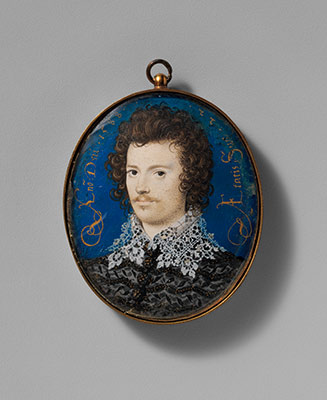
I was very unwilling to enter into it, as you may imagine, without the knowledge and approbation of his mother; but I was too young and loved him too well to be so prudent as I ought to have been
Approbation means the "action of expressing oneself pleased or satisfied with anything; or the mere feeling of such satisfaction; approval expressed or entertained" (OED).
According to the customs of the time, parents were to be consulted about a marriage and their opinion to be taken in high regard; however, men and women were mostly free to choose their marriage partner. If a young adult did choose someone who their parents disliked, they might be left out of the will or, if they are underaged, they may have permission withheld from them. Parental opinions were often respected by young people. ( Elizabeth Maurer, "Courtship and Marriage in the Eighteenth Century", Web.)
but her powers had received no aid from education, she was ignorant and illiterate, and her deficiency of all mental improvement, her want of information in the most common particulars, could not be concealed from Miss Dashwood, in spite of her constant endeavour to appear to advantage. Elinor saw, and pitied her for, the neglect of abilities which education might have rendered so respectable;
Some girls born into affluent families may have been educated at home by parents, a live in governess, tutor, or may have gone off to a private boarding school. Since women did not go on to have careers in this day, education and knowledge was something reserved primarily for boys.
Domestic trainings were a more appropriate education for a woman to receive. "For women of the 'genteel' classes the goal of non-domestic education was thus often the acquisition of 'accomplishments,' such as the ability to draw, sing, play music, or speak modern (i.e. non-Classical) languages (generally French and Italian)" (The Republic of Pemberley, "Education, Women's Education, and Accomplishments")
she had now therefore nothing to do but marry all the rest of the world
“The choice of a spouse was not solely left up to the suitors. Parents and even the wider community had an interest in securing suitable matches, between men and women of similar status, wealth, and age, and they exerted pressure accordingly“ ( Robert B. Shoemaker, Gender in English Society 1650-1850: The Emergence of Separate Spheres, p. 93 )
Because you are so sly about it yourself, you think nobody else has any senses; but it is no such thing, I can tell you, for it has been known all over town this ever so long. I tell everybody of it and so does Charlotte.”
Example of how gossip plays a big role in society. Gossip is how information goes around and status can go up and down.
When they had paid their tribute of politeness by curtesying to the lady of the house
This was also custom and simple manners when attending a party. It is offensive if this action was dismissed. It is a way of introducing oneself to the host/hostess and showing gratitude for the invitation.
ascended the stairs, heard their names announced from one landing-place to another in an audible voice, and entered a room splendidly lit up
During this time, the purpose of this was just so that your presence was known and acknowledged. This is custom.
As Martha Stoddard Holmes suggests, nineteenth-century thinkers were among the first to see disability as a cause of individual suffering, which has the problematic consequence of minimizing “the importance of the material circumstances that surround all disabilities” while maximizing “the importance of personal agency while minimizing the need for social change” (Fictions of Affliction 28-9).
This part of the article stands out to me for a number of reasons. First, the idea that people with physical and mental disabilities prior to the nineteenth century suffered in a difference sense compared to what they deal with now. Prior to this point, this introduction points out the stereotypes that people with disabilities had in the eighteenth century. Though this is something that is still socially dealt with now, we've taken further measures to help people who deal with specific setbacks that emphasis the overall point on maximizing "the importance of personal agency," and minimizing social change. Overall, this article interests me because it allows me to think deeper about how disabilities have always existed, though they've been handles in a variety of different ways as well as reflect it to how it's handled regarding circumstances we've learned including the role of the doctor and what they can do to help and the resources we had access to then versus now.
Old Allen is as rich as a Jew — is not he?
This expression became common in the Middle Ages during a time where majority of the merchant class was Jewish, making the Jews among the most wealthy of the time (Dictionary of Phrase and Fable: R, 1894).
Nobody can fasten themselves on the notice of one, without injuring the rights of the other. I consider a country–dance as an emblem of marriage. Fidelity and complaisance are the principal duties of both; and those men who do not choose to dance or marry themselves, have no business with the partners or wives of their neighbours.”
I feel as though this quote says a lot about the how relationships were built in that time period but also in this story. Not only that but how the roles were set for men and woman. The man is so be the leader and the woman fallows. I do find it an interesting comparison with marriage being seen as dancing. In this example would you say Catherine and Mr. Tilney are dancing around each other?
“Do not be frightened, my dear Catherine,” whispered Isabella, “but I am really going to dance with your brother again. I declare positively it is quite shocking.
"A young woman did not dance more than two pairs of dances with the same man or her reputation would be at risk. Even two dances signaled to observers that the gentleman in question had a particular interest in her" (Maria Grace,“The High Stakes of Etiquette for Young Ladies in the Regency” ).
Captain
"Originally Captain-Lieutenant, becoming Captain in 1772. Lat. capitaneus "chieftain", from Lat. caput "head". Chieftain or head of a unit. As armies evolved his post came to be at the head of a company, which by the Sixteenth Century was usually 100 to 200 men. That seemed to be the number one man could manage in battle" (Harding, British Army Ranks).
fifty guineas
This would be the equivalent to roughly $2,000 today ("Currency Converter").
fifty thousand pounds
This would be the equivalent to roughly $2,000,000 today (“Currency Converter”).
country–dancing
"A rural or traditional dance, esp. in England and Scotland; spec. one in which couples begin by standing face to face in long lines" (OED).

cotillions
"The name of several dances, chiefly of French origin, consisting of a variety of steps and figures" (OED).
sword–case
"A case to hold a sword; in mod. use, a receptacle at the back of a carriage for swords, sticks, or other articles" (OED).
Curricle
"A light two-wheeled carriage, usually drawn by two horses abreast" (OED).

Did not we agree together to take a drive this morning?
“Do not accept an invitation to visit any place of public amusement, with a gentleman with whom you are but slightly acquainted, unless there is another lady also invited. You may, as a young lady, go with a relative or your fiancée, without a chaperon, but not otherwise” (Florence Hartley, The Ladies' Book of Etiquette, and Manual of Politeness, 173).
Caractacus
A king of ancient Britons during the Iron Age who ruled from 43-50 AD, his successful attempts at expansion are believed to be the catalyst for the Roman invasion of Britain (Hill).
Alfred the Great
Alfred the Great was king of the southern Anglo-Saxon kingdom of Wessex and was known for social and educational reforms as well as military success. He is also the only English monarch known as "the Great" ("Alfred the Great").
Agricola
Agricola was a Roman statesman and soldier that governed over Britain and conquered large areas of northern England, Scotland, and Wales ("Agricola").
phaetons
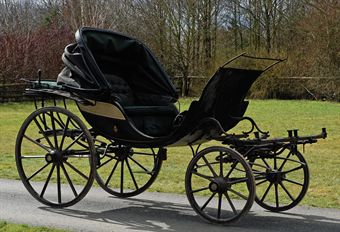 "A type of light four-wheeled open carriage, usually drawn by a pair of horses, and having one or two seats facing forward" (OED).
"A type of light four-wheeled open carriage, usually drawn by a pair of horses, and having one or two seats facing forward" (OED).
the lady had asked whether any message had been left for her; and on his saying no, had felt for a card, but said she had none about her, and went away
Here, the narration refers to a “card”, which is more properly known as a calling card. A calling card -- or visiting card-- is defined as “a card bearing a person’s name and address, sent or left in lieu of a formal social or business visit; a visiting card” (OED). Originally a Parisian trend, these cards were either sent or left at a person’s place of residence to denote that acquaintance had formally visited while they were away or later intended to visit them (Robert Chambers, The Book of Days, np).
It was too dirty for Mrs. Allen to accompany her husband to the pump–room
The pump room -- better known as The Grand Pump Room -- was a building used for upper-class social gatherings and parties in Bath. It was especially popular during Jane Austen’s lifetime (Michael Forsyth, Bath, 68) (Mabel Van Niekerk, The Ancient Roman Cities of Bath and York, 24).
Going to One Wedding Brings on Another?
There is no evidence for a song with this title existing. During the Georgian period wedding hymns were often sung at parties that were not weddings, just for fun. However, the lyrics for this particular hymn does not exist. Austenites speculate that the author invented this title as an excuse for John Thorpe to suggest marriage to Catherine (ODP).
greatcoat
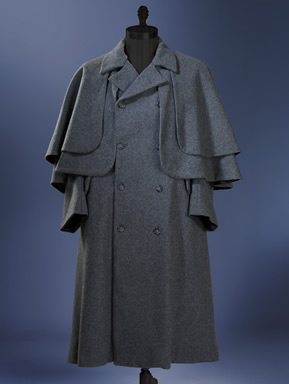
Greatcoats were a type of caped trench coat/ over coat that first came into use by the military in the 17th century, then evolved into casual wear for the upper class. They were made of thick wool and thus expensive for average people to own. However, by the time of the Industrial Revolution and Jane Austen's death, they were becoming more and more available to the middle and lower classes as well (ODP).
sprigged muslin
"Any of various lightweight cotton fabrics in plain weave. Also: a piece of such fabric; a dress or other article of clothing made of muslin" (OED).
From the 17th century to the late 18th century, muslin fabric was mostly imported from places like India. The fabric was used for dresses and curtains and was notably well liked for its simplicity; its ability to drape beautifully; and for the fabric's ability to take paint, dyes, and embroidery very well. Muslins were mostly worn by gentility in the color white. The color white was used to signify the gentility's wealthy lifestyle because white garments were harder to keep clean and were very expensive to constantly have laundered to maintain the pure white color. (Jane Austen’s World)
Here is an example of a sprigged muslin which is named for the muslin's unique design which resembles sprigs of leaves or flowers all over the dress: 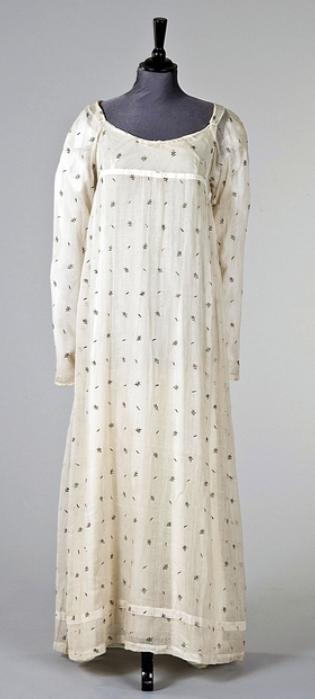
pump–room

"The Pump Room in Bath was built in the lower part of the town, and it was where those taking the “cure” would drink copious amounts of the warm spring water in order to effect a cure" (Austenonly). It was the place to be in high society.
Catherine then ran directly upstairs, and watched Miss Thorpe’s progress down the street from the drawing–room window; admired the graceful spirit of her walk, the fashionable air of her figure and dress; and felt grateful, as well she might, for the chance which had procured her such a friend.
Here Austen is having Catherine admiring Isabella because of her charm that she possesses to her move up in society. She can see here how Isabella uses her appearance to win over people not to mention her manners. It brings up the thought of why there were so many balls during this time period. What was expected of women? The balls that Austen describes seem to be more like debutante ball. A Debutante ball is when younger women are brought into society so they can meet eligible men to marry but also be seen as ladies.
She liked him the better for being a clergyman, “for she must confess herself very partial to the profession”; and something like a sigh escaped her as she said it.
What is a clergyman? Jane Austen draws from her personal life in her novels pulling in her father’s job position. Clergyman in her novels a lot because it draws from her childhood of her father being one. Not only in Northanger Abby but also in Mansfield park its mentioned men to become clergymen. What is so significant to become of this position? According to Merriam-Webster a clergyman is defined as “a man who is a member of the clergy especially in a Christian church”. Breaking this down even more what does the word clergy mean? It means to be ordained in the church. The clergyman seems to be appear to be a minster who is a socialite among the wealthy. They would perform religious ceremonies in the Christian Church only but also were invited to socialize with the upper class at times.
Work Cited Miriam Webster.Com
The master of the ceremonies introduced to her a very gentlemanlike young man as a partner
The master of ceremonies was an official position in fashionable towns like Bath. Their job was to oversee the balls and parties. Their duties spanned from enforcing the rules and keeping the peace to making sure everybody was dressed correctly. As we see in this line, one of their most important jobs was to introduce young men and women (Austenonly, "The Master of Ceremonies: The Georgian Assembly Room, Part Four", https://austenonly.com/2013/02/28/the-master-of-ceremonies-the-georgian-assembly-room-part-four/ ).
There goes a strange–looking woman! What an odd gown she has got on! How old–fashioned it is! Look at the back.”
In response to the French Revolution, by the late 18th century, constricting, formal styles of dress, reminiscent of French aristocracy went out of fashion. Instead, looser styles of dress, inspired by classical Greek and Roman fashions, rose in popularity. Lightweight, sheerer materials, such as muslin were popular, as was an empire style waistline ("Lord Scott", An Introduction to Ladies' Fashions of the Regency Era, http://www.wemakehistory.com/Fashion/Regency/RegencyLadies/RegencyLadies.htm ).
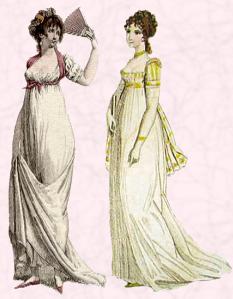
she longed to dance, but she had not an acquaintance in the room
During this period in England, men and women could not interact, much less dance together, unless they were formally introduced by somebody that they were both acquainted with (Maria Grace, The High Stakes of Etiquette for Young Ladies in the Regency, https://kimrendfeld.wordpress.com/2013/04/29/the-high-stakes-of-etiquette-for-young-ladies-in-the-regency/ ).
turban
“A woman’s hat designed to resemble a turban” (OED). This was a fashionable headdress for women from the 1790's through the 1820's, inspired by English trade with India (Walford, Vintage Fashion Guild).

a large Newfoundland puppy and two or three terriers
According to the American Kennel Club, The Newfoundland is a massive breed of English working dog, used for pulling nets, carts, and carrying loads. Newfoundlands also make excellent guard dogs. Henry's puppy would look something like this,
 but would grow to be a very large dog.
but would grow to be a very large dog.

Terrier is a group of breeds, originally bred to hunt vermin. Some examples include the West Highland White Terrier,  Cairn Terrier,
Cairn Terrier,  and Norfolk Terrier.
and Norfolk Terrier. 
These dogs were kept not only as companions, but as useful parts of the household: the Terriers to control rats and other vermin, and the Newfoundland (when grown) for protection and labor. Even so, the Newfoundland’s sweet disposition would make for an ideal companion (American Kennel Club).
rubbed her temples with lavender–water
Lavender was used as an essential oil at the time (and even today) that would help to calm one's anxieties, whether through ingestion or scent. When rubbed on the temples, a person could better smell the oils to calm themselves (Lavender, Maria Lis-Balchin, 156).
curate
"A member of the clergy engaged as assistant to a vicar, rector, or parish priest", or "A minister with pastoral responsibility" (OED). In this context, Henry either has engagements (appointments) to keep with his assistant, or he has engagements (duties) of his own as a clergyman.
post–masters
"A person with official charge of post. The official at each of the stations or stages of a post-road; primary duty to carry mail to the next state" (OED).
cravats
“A long, narrow piece of linen, muslin, or other fine cloth, worn around the neck and either tied under the chin in a knot or bow with long flowing ends” (OED). 
all the dirty work of the house was to be done by two pair of female hands at the utmost
Catherine says in the novels only two women do the work, but in abbeys and castles of the period, there were about eighteen or more servants, ranging from cooks to laundry maids (countryhousereader, "The Servant Hierarchy", 2013). 
a letter
"[...] letters were written on sheet[s] of paper that were folded and sealed [...] Envelopes were not used" (Jane Austen's World, Vic, "Letter Writing in Jane Austen’s Time").
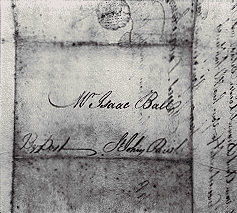
a bilious fever
When referring to disease, bilious is an overproduction of bile. Drawn from Hippocrates's now obsolete Theory of Four Humors, bile was also connected to a bitter and choleric personality (U.S. National Library of Medicine, The World of Shakespeare's Humors).
To poultice chestnut mare” — a farrier’s bill!
A remedy for cuts, swelling, and infection, specifically common for treatment of hoof abscesses. The herb poultice would be applied by the farrier (horseshoer), who in regency times often doubled as a general veterinarian and animal dentist (BookDoors).
pamphlets
Unlike the typical pamphlets we may think about today, in this era, pamphlets were used for political information.
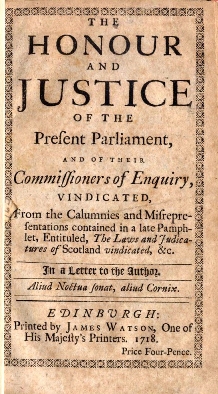
scullery
“A small room attached to a kitchen, in which the washing of dishes and other dirty work is done” (OED).


the pump–room
A meeting place for upper-class people. Mrs. Allen's favorite place was situated closed to the main entrance of the Roman Baths. It is well-known for the power of its waters. The place is still popular today at tea time thanks to its restaurant ("Jane Austen World").

arch
Usually referring to, "women and children, and esp. of their facial expression: Slily saucy, pleasantly mischievous" (OED).
abbeys
An abbey is "A private residence, school, etc., formerly (part of) an abbey" (OED).
a traveling–chaise and four
A traveling chaise was a mode of quick transportation used by rich people, in the eighteenth century. This type of chaise was a closed carriage, which was equipped with four horses. The equipage, which was expensive, was generally composed of two men driving the two horses at the front and sometimes one postilion seated at the back ("Legacy Owensboro").

to be introduced to her
"To make known in person, esp. in a formal manner, with announcement of name, title, or other identification" (OED).